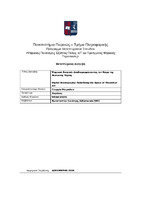Ψηφιακά σκηνικά : αναδιαμορφώνοντας τον χώρο της θεατρικής τέχνης
Digital scenography : redefining the space of theatrical art

View/
Keywords
Theater ; Set design ; Digital scenography ; Art theory ; Σκηνογραφία ; Ψηφιακές τεχνολογίεςAbstract
This thesis, titled “Digital Scenography: Redefining the Space of Theatrical Art”, explores the
integration of traditional scenography with technological advancements, focusing on the
transformation of theatrical space in the digital age. Through an interdisciplinary approach, the
study highlights the dynamic potential of digital tools in the art of theater, addressing scenography
from both theoretical and practical perspectives.
The thesis is structured into two parts. The first part concentrates on the theoretical analysis of
scenography, starting with its historical evolution (Chapter 1), which traces the transition from the
classical era, through the Middle Ages, Modernism, and Postmodernism. Chapters 2 and 3
examine the relationship between scenography and modern technologies, emphasizing
interactivity and the audience’s role in contemporary theatrical experiences. Chapter 4 explores
sustainability, proposing digital solutions that support eco-friendly set designs. Furthermore,
Chapter 5 analyzes the relationship between directing and scenography, while Chapter 6
investigates the challenges and constraints of digital scenography.
The second part focuses on the practical application of scenography through case studies of
theatrical productions staged at the National Theatre. These productions demonstrate diverse
approaches to scenographic design, ranging from large-scale productions to smaller,
experimental ones. The selected plays include The Master Builder, Woyzeck, and The Inquiry of
the Governor of Smyrna. This study highlights the evolution of scenography as a result of the
interaction between art and technology, emphasizing the challenges and opportunities presented
by the digital age in the realm of theatrical art. The thesis concludes with findings regarding the
future direction of scenography and the potential for further innovation in the theatrical domain.


